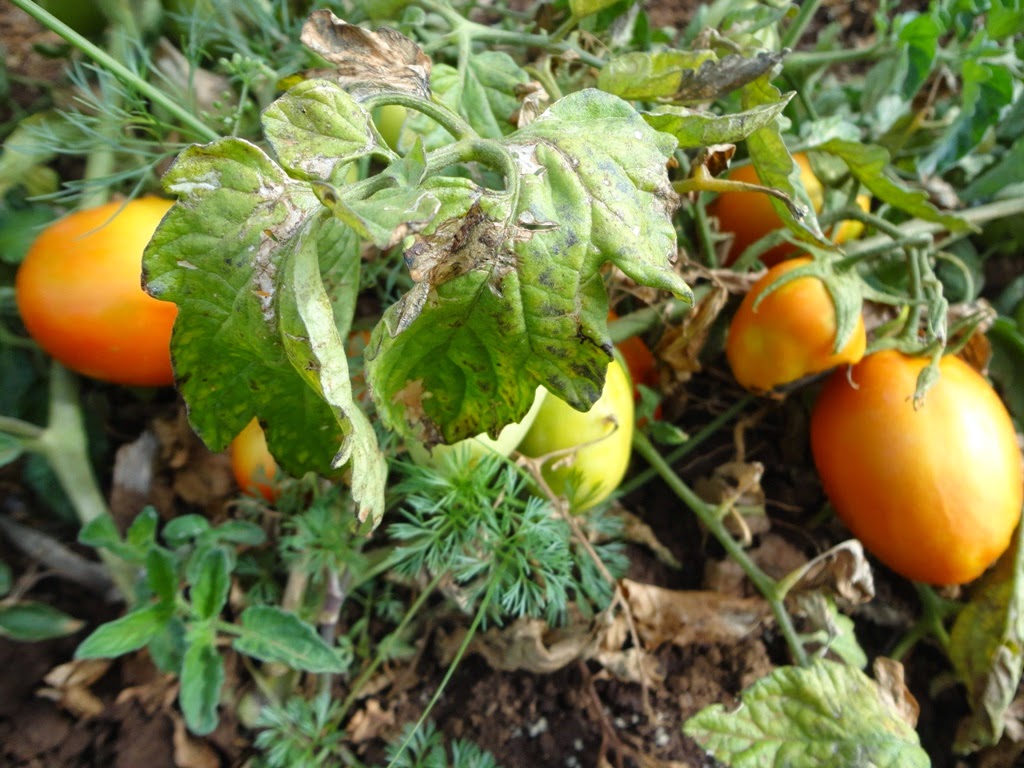By Bob Aston
Syngenta Kenya on March 27, 2015 trained 20 stockists and lead farmers on tuta absoluta disease also referred to as leaf miner at Coconut Hotel in Wiyumiririe, Laikipia East Sub County. The training was held to help the stockists and lead farmers to understand pests and diseases and particularly tuta absoluta.
Syngenta Kenya on March 27, 2015 trained 20 stockists and lead farmers on tuta absoluta disease also referred to as leaf miner at Coconut Hotel in Wiyumiririe, Laikipia East Sub County. The training was held to help the stockists and lead farmers to understand pests and diseases and particularly tuta absoluta.
Speaking during the training, Mr.
Daniel Njoroge from Syngenta Kenya informed the stockists and lead farmers that
they need to understand how the pests and diseases feed, when they feed, their
growth stage, breeding cycle, life cycle and blood circulation as well as the
correct dosage of insecticides.
 |
| Infected tomato leaves |
He noted that tuta absoluta is a
devastating pest affecting tomatoes and is considered to be a serious threat to
tomato production. He said that the pest is easily found on tomato plants
because it prefers the apical buds, flowers or new fruits where the black frass
is visible. The pest which originated from South America is said to breed
between 10-12 generations a year. Each female can lay 250-300 eggs in her life
time.
“Stockists are and are still the first
level of contact by farmers thus it is important to have enough knowledge about
the pest so that you are able to advice farmers accordingly when they seek
information about the pest,” said Mr. Njoroge.
He said that prevention and proper management
of the pest is crucial thus farmers need to adopt an integrated pest management
strategy to control the pest. He noted that the pest usually develop resistance
to insecticides when used more than three times. The infestation of Tuta
absoluta has also been reported on potato, watermelon and common beans.
There are 4 instars. Early instars
are white or cream with a black head, later they turn pink or green. Fully
grown larvae drop to the ground in a silken thread and pupate in soil. Pupation takes place in soil on plant parts
such as dried leaves and stems. Adult female lives 10-15 days while adult male
lives between 6-7 days. Seventy (70) percent of its eggs are on the leaf.
He said that the larvae usually feeds
voraciously upon tomato plants, producing large galleries in leaves, burrowing
in stalks and consuming apical buds and green and ripe fruits.
 |
| Infected tomato fruit |
“The pest usually affects both
tomatoes in green houses and open fields. They are most destructive at larvae
stage. Without proper care a farmer can experience 100 percent yield loss due
to tuta absoluta,” said Mr. Njoroge.
Signs and symptoms include; puncture
marks on the surface where the larvae has entered, abnormal shape, exit holes, rot
due to secondary infective agents and frass produced at stem nodes where larvae
have bored into the stem.
Control of tuta absoluta
Tuta absoluta has proved very challengin to
control. Effectiveness of chemical control is limited due to insect's nature of
damage as well as its rapid capability of development of insecticide resistant
strains.
The use of biological factors is
still largely under development and not ready to combat this pest effectively
and in a cost effective way. Sex pheromone trap (TUTRACK) that has
been developed by Kenya Biologics limited has been an effective tool for early
detection of the pest.
Mass trapping and lure which contains
pheromone has been found to be effective to control Tuta absoluta by
attracting and trapping the male Tuta absoluta moth.
Tomato farmers are also advised to
exercise hygiene in their farms to reduce the effect of tuta absoluta, uprooting and burning suspected crops and also
avoiding throwing tomatoes remains near their farms.
According to the International
Plant Protection Convention (IPPC) the government of Kenya has put in place
elaborate trapping program and pest management that includes: integrated pest
management, use of traps, introduction of biological control agents and
imposition of quarantine in affected areas.
No comments:
Post a Comment